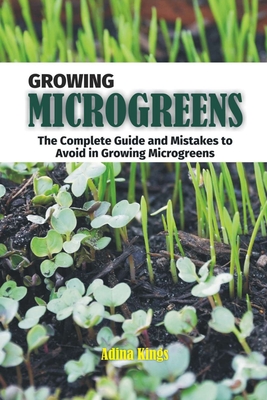You are here
Back to topGrowing Microgreens: The Complete Guide and Mistakes to Avoid in Growing Microgreens (Paperback)
$12.64
This item is not available this time
This item is not available this time
Description
Growing Microgreens
Any delicious seed that sprouts quick is a great choice for microgreens. More colors = more nutrients, so lean into rainbow-colored radish, purple basil, crimson amaranth and everything in between
Some examples of microgreens:
- Broccoli, arugula, asian spinach, mustard & kale often sprout within 24 hours & are harvested 10 days later, not to mention they are so delicious as well as versatile
- More colors = more nutrients so revel in our confetti rainbow radish mix, purple radish seeds (below) as well as our vivid red amaranth Red beets often take about one week longer to harvest, but so worth it: They are just gorgeous.
- Quick-growing microgreen herbs like basil, dill and cilantro are not as quick as broccoli & other brassicaceous (isn't that a lovely word? ) microgreens, though they are the most delicious & add so much life to our soups & curries all winter long.
Also, if you're like us and cringe to waste anything (especially a seed ), here is some great news: growing microgreens is an easy way to use old seed without letting them go to waste. Even as germination rates may drop as seeds age, microgreens are sown so densely that it generally works out brilliantly. What Are Microgreens?
Microgreens are young vegetable greens that are approximately 1-3 inches (2.5-7.5 cm) tall.
They have an aromatic flavor and concentrated nutrient content and come in a variety of colors and textures.
Microgreens are considered baby plants, falling somewhere between a sprout and baby green. Different Types of Microgreens
Microgreens can be grown from many different types of seeds.
The most popular varieties are produced using seeds from the following plant families:
- Brassicaceae family: Cauliflower, broccoli, cabbage, watercress, radish and arugula
- Asteraceae family: Lettuce, endive, chicory and radicchio
- Apiaceae family: Dill, carrot, fennel and celery
- Amaryllidaceae family: Garlic, onion, leek
- Amaranthaceae family: Amaranth, quinoa swiss chard, beet and spinach
- Cucurbitaceae family: Melon, cucumber and squash
- The detailed step-by-step on to start growing your own microgreens
- The processes of preparing and planting seeds
- How to harvest
- The different growing media for microgreens
- Health benefits of microgreens
- Soil recycling
